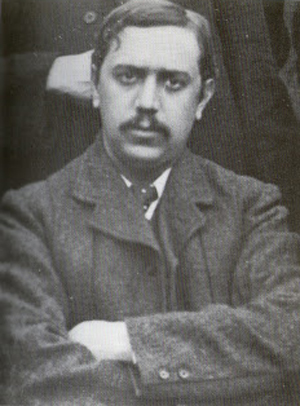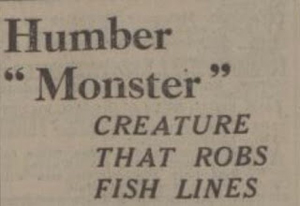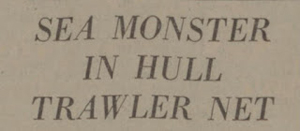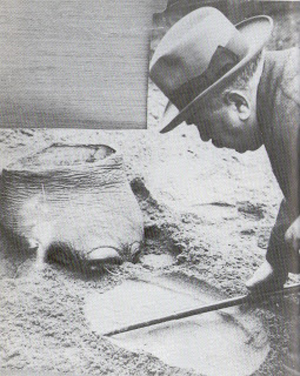One Hull Of A Story: The Kraken of Hull Museums
An article by Hull historian and writer Mike Covell. Follow Mike of his Amazing Hull Tours facebook page and his Twitter feed.
Visit the Hull Maritime Museum at the moment and you will be greeted with the Pirates and Privateers exhibition, a fascinating look back at the swashbuckling scoundrels of yesteryear. On a recent visit I came face to face with Captain Jack Sparrow, or at least his outfit from the Pirates of the Caribbean movies. It is during these movies that the Kraken is unleashed, a mythical sea monster that wrecks havoc during the Pirates of the Caribbean: Dead Man’s Chest and in Pirates of the Caribbean: At World’s End. The story reminded me of a period in Hull’s history where mythical sea serpents were not actually that far away!
|
Between the years of 1920 and 1936, the Hull press was full of newspaper reports of sea monsters in the Humber and along the East Yorkshire Coast! For the past decade I have been collating these reports and studying the sightings, which were probably mistaken for whales and porpoises, but they make for interesting reading, especially when you realise that playing a central part in the story, and using the “Sea Serpent Scare” to boost tourist figures in the Hull Museums was Thomas Sheppard.
Thomas Sheppard (October 2nd 1876 – February 18th 1945) was born in South Ferriby who became the first curator of the Hull Municipal Museum, which was held at the now lost Royal Institution on Albion Street, opposite where Hull’s Central Library stands today on the car park. Initially the museum, which was based on the collection of the Hull Literary and Philosophical Society, which was founded in 1822, was a paying museum. When Mr. Sheppard took over he closed the museum, refurbished it, and reopened it in 1902 making it a museum with no admission charge. Sheppard’s work in Hull was well known and well loved, his articles on all manner of local history would make regular appearances in the columns of the Hull press, and his character and drive led to the founding of the Pickering Museum of Fisheries and Shipping (founded in 1912) and the Commerce and Transport Museum (founded in 1925) two museums which have evolved into the Maritime Museum, The Transport Museum, and the Hull and East Riding Museum. Sheppard was also instrumental in the founding of the Wilberforce Museum (founded in 1906). |
|
So how is Mr. Sheppard linked to the mystical and mythical Kraken of the Humber?
It all started in May 1886, when the Hull Daily Mail published a report on the Hull steamer, The Durham, which was heading to Philidelphia when it came across a “sea serpent.” [1] From there on out the Hull press was full of reports of sea serpents from around the world, but here in Hull our fishing trade was still booming and the fishermen were still taking to the sea and bringing back hauls of fish to the busy docks that line the Humber. Then, in July 1929, a couple were on holiday at Hornsea, when they reported seeing a “sea serpent” swimming a mile off the shore. The sighting made headline news in the Hull Daily Mail. [2] By the 1930’s the world was gripped with Loch Ness Monster fever, when sightings at the Loch made headline news across the world, with the Hull press covering the story on numerous occasions. [3] [4] |
Then, in February 1934, the headlines were filled with a new “sea serpent,” that had been seen in the Humber. It was reported that a large black unidentified object was seen swimming in the Humber. It was announced with great passion in the press, and made fishermen in Hull, Grimsby and Cleethorpes take to the newspapers to argue over what they had seen. [5]
From that point on the Hull press was filled with reports on the “Humber Monster” and the “Humber Sea Serpent,” with reports flooding in and articles appearing almost daily. [6]
Then, in October 1938, it was announced that Hull trawlermen had captured the monster, and its skull was put on display. The trawler Deepdale Wyke has been fishing in Icelandic waters when they captured something unexplained in their net. It was brought to Hull and taken to the headquarters of the West Dock Steam Fishing Co, where it was put on display. No one, not even the seasoned fishermen, could identify it, but sadly its location today remains a mystery. [7]
From that point on the Hull press was filled with reports on the “Humber Monster” and the “Humber Sea Serpent,” with reports flooding in and articles appearing almost daily. [6]
Then, in October 1938, it was announced that Hull trawlermen had captured the monster, and its skull was put on display. The trawler Deepdale Wyke has been fishing in Icelandic waters when they captured something unexplained in their net. It was brought to Hull and taken to the headquarters of the West Dock Steam Fishing Co, where it was put on display. No one, not even the seasoned fishermen, could identify it, but sadly its location today remains a mystery. [7]
|
Then it happened, an event that so scared the people investigating it that they did not dare report on it for fear of scaring the masses. Footprints coming from the Humber, at Spurn Point, and heading in the direction of Hull were discovered. Reporters, from the Hull Daily Mail, were dispatched, as was a photographer, who took several photos of the strange sea serpent tracks.
Thomas Sheppard unexpectedly turned up on the scene and made some observations on the prints. He was photographed measuring them and analysing them with his walking stick and as the reporters were about to rush to press, he announced that he had made the prints himself. He used an old elephant’s foot, which was from his office, to make prints in the sand at Spurn Point. The elephant’s foot was actually a waste paper basket, and Mr. Sheppard used the story to drum up interest in the museums at Hull. Today the actual identity of the “Humber Monster” remains a mystery, with theories put forward that it was all hoaxes, misidentification or natural explanations, such as whales. |
The elephants foot is still on display at the Hull Museums, and next time you are in the foyer of the Transport Museum, be sure to check out the display of Mr. Thomas Sheppard’s Desk, for there in the corner, is his elephants foot, that caused a sensation and made many believe that the Kraken was trying to pay a visit to the Hull Museums!
References and further reading:
1 The Hull Daily Mail, dated Friday May 14th 1886
2 The Hull Daily Mail, dated July 9th 1929
3 The Hull Daily Mail, dated Friday December 15th 1933
4 The Hull Daily Mail, dated December 28th 1933
5 The Nottingham Evening Post, dated February 3rd 1934
6 The Hull Daily Mail, dated February 6th 1934
7 The Hull Daily Mail, dated October 28th 1938
The Hull Daily Mail: A Part of the Community, Barbara Robinson, 2009
The Amazing Mr. Sheppard, Hull Geological Society,
The Hull History Centre holds numerous records, articles and newspaper clippings on Thomas Sheppard.
1 The Hull Daily Mail, dated Friday May 14th 1886
2 The Hull Daily Mail, dated July 9th 1929
3 The Hull Daily Mail, dated Friday December 15th 1933
4 The Hull Daily Mail, dated December 28th 1933
5 The Nottingham Evening Post, dated February 3rd 1934
6 The Hull Daily Mail, dated February 6th 1934
7 The Hull Daily Mail, dated October 28th 1938
The Hull Daily Mail: A Part of the Community, Barbara Robinson, 2009
The Amazing Mr. Sheppard, Hull Geological Society,
The Hull History Centre holds numerous records, articles and newspaper clippings on Thomas Sheppard.
|
Join the One Hull Of A City facebook group, and spread the word!
|

One Hull Of A Story: The Phantom Cannons Of Hull - The bizarre account of hundreds of people in and around the city, hearing the sound of war, but there was no war or armies in the area.
|
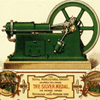
One Hull Of A Story: Priestman Oil Engine - Invented and produced in Hull, the first commercially produced oil driven internal combustion engines in the 1880s.
|


